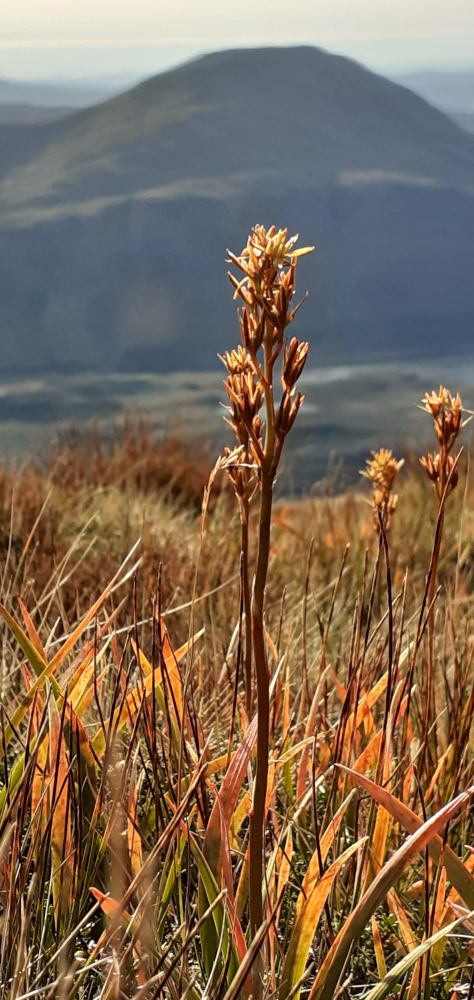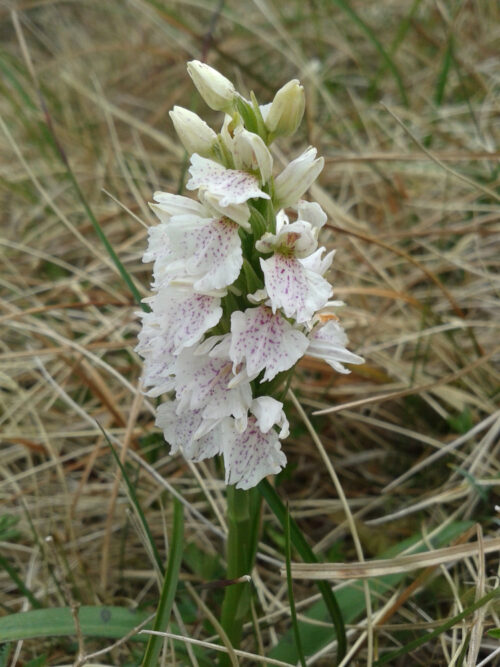kindling

Bog asphodel, Arkle, looking over to Ben Stack, Sutherland, Scotland
16th September 2020

Bog asphodel, Arkle, looking over to Ben Stack, Sutherland, Scotland
16th September 2020

Two-banded longhorn beetle (according to Assynt Field Club) on the summit of Ben More Assynt, Sutherland, Scotland
1st June 2020

Villingardalsfjall, Viðoy, Føroyar / Faroe
22nd June 2019
After that moment of pure terror on the mountainside – when I clung to the sliding scree in desperation, the fjord deep and blue below me – I’ve finally reached the summit and sit at its northern precipice, looking down. Fog blows up at me in cold gusts. It’s hardly a surprise: the whole summit has been crawling in cloud since I arrived but, unlike the dull clamminess I’ve come through, this fog is lit from the inside. It seems sourceless, blowing up out of nowhere in swirling puffs and, other than the lumpy rock immediately around me, I can see nothing else. I would have thought I would be disappointed: to have come all this way – by sea, by bus, by painstaking foot and hand – and not be able to see the view from this most northern Faroese peak. Yet I find I am grateful. After that terrifying moment below, to be here now in the presence of this unseen luminance, this blind light…
I become still and let it absorb me. I hear birds cackling, wind in small gusts; I see moss shining quietly when the fog is blown thin for a moment. And it’s such a beautiful fog. It fills my brain, like a dream I can’t wake from – a bright mist, a lucent opacity, a billowing emptiness I don’t ever want to leave.
Villingardalsfjall, Viðoy, Føroyar / Faroe
22nd June 2019
a maniacal butterfly
and a bee bombing about
and my limbs aching in their driving desire
in the drenching blue sun
in the scouring white wind
on the stones
on the bones
on the bare back of Scotland

Quinag / A’ Chuinneag, Assynt, Scotland
5th May 2015

Heaval, Barra, Western Isles Scotland / Barraigh, Eilean Siar, Alba
23rd April 2017
The passing sunlight makes a cross on the worn wooden floor of the bothy. Outside the great mount of Suilven heaves around the winds.
Sun. Hill. Shelter.
Observance. Love. Relief.

Suileag bothy, Assynt, Scotland
10th September 2016
Everything’s done that needs to be. The hills are heaped up, the moors stripped down, the beaches lovingly spread. The deer are taking care of themselves, ambling in their steady streams down and up the slopes.
There’s nothing to do here.
What a relief.
Lochinver, Assynt, Scotland
3rd September 2016
Nantai means ‘man’s body’ and the body of the mountain is varied. I climb through tree roots and torii (shrine gates), clamber over boulders, and slip on muddy sand and sharp rubble. The mountain is a volcanic cone, much like Mount Fuji, and it is a sacred mountain, a shintai, something which holds kami, spirits.
The path to its summit is difficult yet popular. By mid-morning, I’m meeting many elderly Japanese who are already on their way down, and several younger (middle-aged) men. The latter are dressed all in white, the colour traditionally worn by mountain pilgrims and the yamabushi, the mountain ascetics who lived here in earlier centuries.
Whiteness appears regularly on the path. The torii at the foot of the mountain, which I passed through to ascend, were dressed in strands of straw rope and hung with the folded zigzags of white paper which indicate a sacred place; and beside the path white plastic strips are tied around occasional tree trunks at eye level.
As I make my way up, I also start noticing fine curls of pale birch skin lying intermittently beside the trail. At first I pocket them as miniature mementos then realise they’re too regularly placed to be chance arboreal sheddings, and start myself dropping them along the way as I continue. The trees themselves are changing as I get higher and white birch trees become more frequent until, at the edge of the trail, on a steep curve of the mountainside, stand a line of them, their loose peels of bark unfurling, and as the breeze catches them, they flutter in the sunlight like the paper strips on the torii.
At a tiny shrine set into a rock face a few hundred feet short of the summit, the birch disappear completely, and the world becomes comprised of twisted pines, bleached dead limbs and stumps, and reddish volcanic soil. A sudden cold wind arrives and, as I climb, the trees and soil finally give out until there’s only sharp lumpy black and red rock, and a steep open rubble slope to the summit.
It’s a surprisingly difficult scramble up but, along with the old lady who’s appeared beside me, I get there. The summit is graced by one main shrine and two smaller ones, and I find a sheltered place to nestle by one of these subsidiary shrines, on the far end of a ridge slanting off to the north.
Lines and lines of blue hills rise and fall into the haze of the western sun (Fuji-san hiding somewhere to the south) and the north is full of steep peaks pointing and spearing the mat of thick grey cloud above them. I’m sitting behind some lumpy black rock, having daifuku (sweet red bean patties) and green tea, when I notice tiny white particles drifting around me. At first I think it’s tiny flies, then I think it’s dust, then I’m sure it’s ash, then, as a tearing wind sets in, I realise it’s snow. I barely get back across the ridge and down to the treeline. The wind is like walls of ice, scouring and freezing. I have never been at this altitude before. The world whitens, sharpens. I am blown away!

Nantai-san, Nikkō, Tochigi, Japan (2486m/8156 feet though I start from Chuzenji at 1269m/4163 feet)
17th October 2014
Rising naked at dawn
gathering a soft shawl for the morning
At sunset
held aloft on a shrug of rosy white cloud

Fuji-san from Fujinomiya, Shizuoka, Japan
14th October 2014